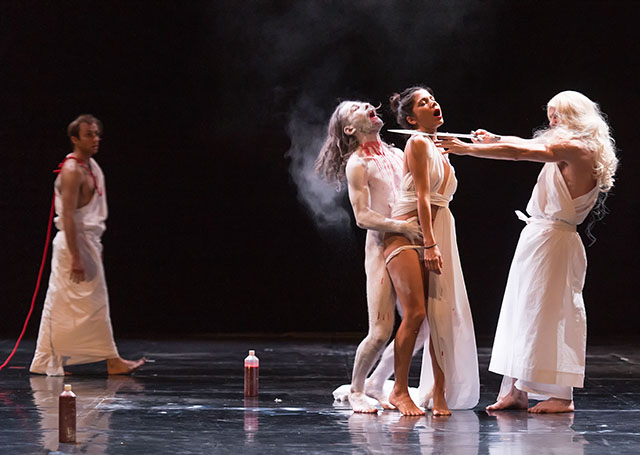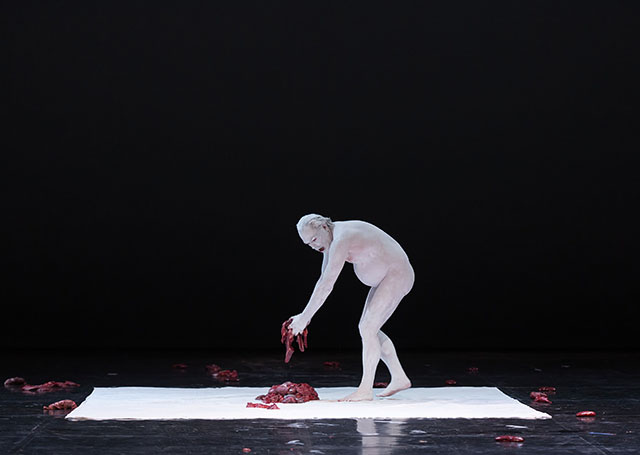Beyond being beauteous, the silent white statues of Dionysus, Zeus, and Aphrodite standing in the museums of Europe and dotting the history of Western neo-classical architecture, all influenced by the temples of Ancient Greece, indicate a lot in terms of politics. The myths of Olympus have been a strong influence for the European culture, from the Bible to the films of Pasolini. And while “Mount Olympus”, the 24-hour contemporary theatre piece by artist and director Jan Fabre that took over Berliner Festspiele as a part of the Foreign Affairs theatre festival from June 27 to June 28, was based on the myths of the divine kingdom of goddesses and gods of Ancient Greece, the EU Parliament was persecuting the Greek Government.
How does a 24-hour performance begin and end? How does the body respond to the process—not only the performers but also the audience? Dionysus, played by Andrew Van Ostade, gave the public of Ancient Greece “a tiny bit of madness”, and “Mount Olympus” kicked off with a fest ruled by the god of the grape harvest, winemaking and wine, of ritual madness, fertility, theatre and religious ecstasy. A group of 27 actors and dancers gathered “to glorify the cult of tragedy”, as was written on the badges—humour, however, was never forgotten.

In a piece that criticises rationality and celebrates sexuality, madness is the core. The (obscure) failure of democracy was depicted through scenes that denounced the violence of the state, of rationality, of linear thinking. “The 24 Hour Project cannibalises theater”, writes Luk Van den Dries in his introduction to the show. Besides the ecstatic moves of 60s religious cults around flesh and blood in “Mount Olympus”, acts like fisting and intercourse with plants worked to queer the white stage. The performance recalls what theorist Elisabeth Freeman calls transtemporal drag. Taking a time period generated through heteronormative history, “Mount Olympus” transforms a specific time and its connotations, bringing several periods to the same moment—using elements from Shakespeare’s Romeo and Juliet or the film A Few Good Men whilst narrating the myth of Ajax on self-conflict, for example—re-instituting in them different norms.

The performance’s text, written by Jeroen Olyslaegers and Jan Fabre, contained lines like “What women are able to do when they are possessed by their own power…”, “Vanity is magic!”, and “Your laws mean nothing!”. Without doubt, the success of the text enriched the performance itself. The brilliant costumes designed by Jan Fabre and Kasia Mielczarek were basically simple white sheet tied in various ways. But despite all the positive adjectives that shall be used to describe the piece, “Mount Olympus” had its problems as well. Rather than using the architectural potential of the building, it remained stuck on the classical stage, for one. And reminiscent of the wrong choice of sauce on a luscious piece of cake, the plain, meaningless images projected embodied nothing, save for the last scene.
Fabre, however, is indisputably a pro in terms of theatre direction. Beyond question, his knowledge of art and theatre and his specific interest in interdisciplinarity—like science and art—is terrific. But although the theatricality—the use of space, bodies, and objects, and their relation to lighting—was powerful, teaming up with a choreographer for the dance scenes would redefine the whole piece. Despite the appealing movements and the vigorous physical attributes of the dancers, banal choreographic forms and dance patterns created a stumbling block. The lack of even one single canon in the dance should inevitably be criticized.

In the so-called last scene, following the chorus “Breathe, just breathe, and imagine something new”, Dionysus assured that it’s just the beginning. Singing the melody of “The End” by The Doors, the God asks: “Is this the end, my obnoxious friend, the end?” Just before the question, beautiful bodies from all ages and sizes dipped in glitter and several colours began to twerk on stage. After 24 hours of sex, blood, tears, shame, celebration, madness, and tragedy, that’s actually how Fabre’s “Mount Olympus” ended. The audience went crazy, and you know what: even Zeus was delighted.
In the aftermath of such a long duration piece, the ecstasy inevitably lingers in the air. Pointing out a clear end is nonsense. Such a pity that the stage—an artwork in itself containing the dirt of the performance: sweat, colours, glitter, sand, oil, flowers, etc.—was scrubbed clean only an hour after.













